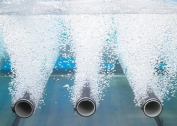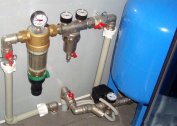According to the experience of residents of private houses, we can conclude that a full treatment of water can be achieved if it comes from a well or a well. If connected to a central water supply, the quality of the liquid will be worse - to improve performance, you will have to use several filters, including membrane technologies.
Causes and signs of water pollution in the well

The fluid in the well does not always meet the standards due to the large amount of dissolved salts, bacteria and the presence of aquatic vegetation. If the source is built correctly, taking into account all the requirements, the risk of pollution will be lower. Well water users should be alert for the following symptoms:
- Turbidity of the liquid may indicate an increase in the percentage of salts. Turbidity appears with very rare use of the source. If the renewal of the liquid due to the lime layer has ceased, the available water will stagnate and deteriorate.
- The yellow color of water is the appearance of iron ions. Black - the reproduction of bacteria that feed on organics.
- A change in taste can also be a sign of salts. For example, the bitter taste indicates magnesium salts, metallic - iron.
- The appearance of an unpleasant odor is also associated with stagnation of water due to rare pumping.
- Poor operation of the pump, improper installation in the well can cause siltation of the bottom, due to which the liquid will stop updating. Most often, the unit is lowered too low to the bottom. It is necessary to reinstall the device and clean the well.
The absence of a lid can cause a cat or dog to fall into the well. In this case, you will have to pump out all the liquid, carry out disinfection measures and refill. Water will need to be checked several times for bacteria before starting to use the source.
When buying a site where there is a well, you should first check the water in the sanitary and epidemiological station for the content of harmful substances, and then equip the water supply.
When constructing wells, it is recommended to make a clay castle around concrete rings so that melt and groundwater do not get inside. Movement of the soil can cause destruction of the protection, and the water in the source will begin to deteriorate. In this case, dig a new well or install a filter system. A layer of clay on the inner walls appears when concrete rings are shifted, if they were not fixed during construction. It is possible to clean muddy water from clay in the well by pumping out all the liquid and installing mechanical filters.
The close location of the well and septic tank with non-compliance with sanitary standards can lead to the constant presence of organic matter in the water. In this situation, you can not do without filters.
Methods for cleaning fluids in wells
There are several types of measures that can be used to purify water from a well in a country house before drinking:
- Automatic. The procedure for installing filters, shields is carried out at the moment when the minimum fluid level in the well is in the summer or early autumn. The remaining water is pumped out, they go down and collect garbage in buckets, then they lift them up. If damage to the rings or cracks is found, they are covered with a cement mortar. At the same time, you can install a filter.
- Biological It is carried out after mechanical cleaning of the bottom and walls. Using a sponge or spray gun, a layer of chlorine solution is applied to them.After this, wait 3 to 4 hours and rinse with clean water. Next, the well is gradually filled and a liter of concentrated bleach dissolved in advance is poured into it. After a day, the liquid is again completely pumped out. Next, you need to take it for analysis and wait for the results.
- Preventive. It is carried out twice a year - after the spring rise of the liquid and before the onset of cold weather. To do this, it is enough to pour potassium permanganate into water and then pump it out completely. You can use it to prepare plants for wintering, when about 300 liters are poured under each adult tree, and 100 liters at a time under the bushes.
It is important to properly draw water into the test bottle. To do this, observe the following rules:
- use a glass or clean plastic container - not suitable for mineral water;
- draw water to the very cover so that there is no air left;
- dial slowly - oxygen is able to accelerate some chemical reactions in the liquid;
- deliver to the laboratory within 3 hours, if it does not work out - put in the refrigerator, but not in the freezer;
- transport in a dark bag.
If some dangerous elements or microorganisms are found in the well, you should consider installing a membrane filter before delivering water to the house.
Methods of purifying water in the country with filters
There are many filters for various purposes:
- to eliminate iron ions;
- antibacterial;
- to soften the fluid;
- mechanical - from rust, sand, silt;
- integrated system for cleaning water from a well in a country house.
It is better to install them immediately - during the construction of the source. You may need the help of a specialist who knows the features of the soil in this area and what can be expected after a while. He will advise what adaptation is necessary for this well and how long it will work.
If, based on the analysis of the liquid, there is no need for bacteriological cleaning, but there is a large amount of iron in the soil, a deferrization filter must be installed. Sometimes they are combined with hydrogen sulfide treatment - hydrogen sulfide is formed during the decomposition of organics.
With increased stiffness, an ion-exchange resin is sufficient, which eliminates excess calcium and magnesium.
If there is access of sunlight to the liquid, it can begin to bloom, green algae will appear. Therefore, it is important to have a tight cover or door.
Reverse osmosis - artesian water in the house
The multistage reverse osmosis system, which gives high quality water, has proven itself well. This is a distilled liquid, which before use can be enriched with the necessary salts of potassium and sodium.
In the reverse osmosis system, the following cleaning steps are provided:
- A mechanical filter that removes large particles of debris, clay and sand. It is installed immediately after the pump, which should be powerful enough and create the right pressure.
- A membrane filter that traps microorganisms - bacteria and viruses, salts of heavy metals, the size of which is up to 0.5 microns.
- Coal cleaning.
Depending on the configuration of the multi-stage filter, an ion exchanger can be added to the circuit to soften the liquid, a device for ionizing water with calcium, sodium and other useful trace elements.
The main element of the system is a porous membrane through which fluid passes under pressure. In a private house with a good pump, this is easier to do than in a high-rise building on the upper floors, where the pressure is so low that you will have to put another pump in the apartment.
Filters in the system must be changed regularly. Depending on the initial purity of the liquid, this time may be individual. If you select a good quality membrane filter, it can be washed periodically with conventional means, then put it back on.





